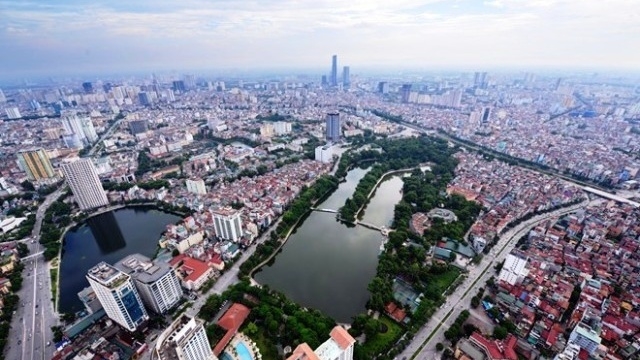
Illustrative image.
In the urban centre, the inner city will consist of the Old Quarter from the southern Red River to belt 2, which preserves the Thang Long cultural heritage and other traditional values of Hanoians, and the expanded urban areas from belt 2 to the Nhue River, where new urban wards with high-quality and modern culture, service and shopping centres will be developed. The expanded area in the south of the Red River from the Nhue River to belt 4, including a chain of urban wards such as Dan Phuong, Hoai Duc, Ha Dong and Thanh Tri will see the development of modern residential wards with cultural, service, trade and finance centres of the region and the nation. The enlarged area to the north of the Red River and the south of the Ca Lo River cover three main urban wards. The Long Bien, Gia Lam and Yen Vien wards will develop service, trade, education and health centres and high-tech industries along National Highways 5 and 1.
The urban centre will be the country’s administrative, political, economic and cultural hub, and will be expanded from the inner city to the west, the south to belt 4, the north to Me Linh and Dong Anh districts and the east to Gia Lam and Long Bien districts. The Party, National Assembly, State and Government agencies and offices will be located in Ba Dinh district and some central agencies will be relocated to Me Tri and to the west of West Lake.
The five satellite urban areas of Hoa Lac, Son Tay, Xuan Mai, Phu Xuyen and Soc Son, will each have specific functions, with the purpose of sharing the demand with the urban centre in terms of housing, training, industry and services.
Accordingly, Hoa Lac satellite town will have the main function of serving science-technology, and training.
Son Tay satellite town has been selected as the urban area of historic culture, resort tourism; focusing on the Son Tay Citadel preservation zone, Duong Lam ancient village and developing the center for tourism associated with Xuan Khanh lake, training services, health and the new urban.
Xuan Mai satellite town will be the urban area of services - industries supporting the development of small industries and craft village systems.
Phu Xuyen satellite town is dedicated to industry, transportation hubs, and transshipment of goods.
Soc Son satellite town will focus on the development of industry and air services, eco-resort tourism, forming the Mai Dinh industrial zone and clean industrial zones; medical centers, universities zone, and will make use of the potential of international airports including Noi Bai, the Trans-Asia economic corridor of Con Minh - Hanoi - Quang Ninh and the landscape of mountain Soc and Mount Tam Dao.
Suburban areas of Hanoi will build a green corridor associated with developing large-scale ecological parks, fresh food and high-grade ornamental plants areas; replicating the model of high-tech agriculture zone in Gia Lam, Dong Anh and Me Linh districts; and establishing large-scale ecotourism destinations in Ba Vi, Soc Son and Huong Son – Quan Son areas.
The current situation shows that there are three feasible models to develop satellite urbans in Hanoi.
The first model is designed to attract foreign direct investment (FDI) in order to implement developing industrial and export processing zones, building urban infrastructure, educational and training activities and projects in satellite urban areas.
The second model involves attracting remittances of the Vietnamese community abroad and overseas Vietnamese entrepreneurs to develop real estate projects in satellite urban areas such as the European Overseas Vietnamese Village project, which was invested by entrepreneurs and Overseas Vietnamese in Poland.
The third model aims to attract high-tech FDI projects in locations that meet demand of the investors, such as the Samsung Group’s research and development centre project in Hanoi.
To attract FDI, Hanoi’s authorities must accelerate administrative reform; improve the processes of planning, investment, building and taxation to support businesses. Numerous trade promotion activities will also be held to attract more domestic and foreign investment. The city has been tackling obstacles overseas investors face in a bid to draw more foreign direct investment and boost socio-economic development. Branches and ministerial departments are required to listen to the complaints of foreign-invested enterprises and offer solutions in a timely manner. In turn, foreign investors are asked to implement their licensed projects on schedule. It also urged site clearance steering boards to work closely with investors on eight projects that were having trouble getting the needed clearance.
Hanoi city has organised conferences to promote investment in industry, real estate, trade and services, and social infrastructure. The forum aims to better advertise the city's investment climate and opportunities to domestic and foreign investors. This is a good chance for local authorities to understand challenges that investors have encountered so far, in a move to improve the city's investment climate and enhance its competition in attracting investment.
Furthermore, the city is expected to focus on attracting investment in industries to promote technology transfer, especially in high-tech, and create jobs and increase exports as well as train human resources and develop infrastructure facilities, support industry and high-quality service.
In the field of industry and construction, the city will focus on enhancing capacity building and position the industry in such a way that it can benefit from advantages and attain competitiveness to join in the global value chain such as support industry, information technology, biotechnology, high technology, microelectronics industry.
According to the Hanoi Master Plan to 2030, the city will be developed sustainably to become a ‘green, cultural, civilized and modern’ city.
The participation of investors both in the country and abroad is essential to the implementation of the plan. The city will draw out appropriated investment orientations in order to ensure sustainable development associated with the reform of administrative procedures at all levels in the promotion, management and deployment of foreign direct investment projects and development assistance programmes.

Leave your comment on this story